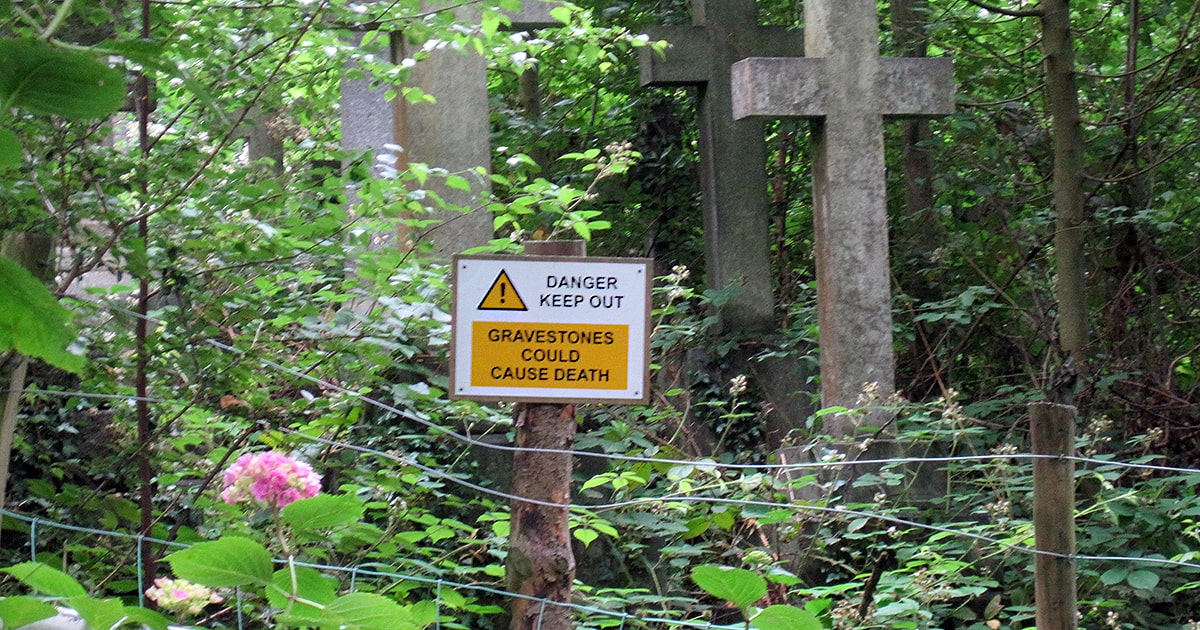The introduction by some local councils and cemetery owners of stability testing and /or a deliberate policy of going into a burial ground and laying flat row upon row of headstones has caused much public reaction. The original explanation that it was a Health and Safety Executive Directive proved to be unfounded, an internal memo in the HSE noted awareness and concern on memorial safety but was not intended for general publication. Some councils have had to re-instate the laid down memorials or pay compensation when they did not follow the correct procedures. In the case of consecrated areas in a public cemetery the council has to obtain a faculty [a legal permit] from the Bishop's Consistory Court. in cases of emergency where stones are deemed to dangerous the Consistory Court can be contacted by telephone.
When stones appear to be unstable it is hoped that burial rights owners and other interested parties would be consulted before any work commences. This is fully covered in the Ombudsman's report - the Ombudsman also states that the laying flat of stones is not the only method and alternative options are available to cemetery owners. The cemetery owner has a duty of care and if the stonework cannot be safely supported or segregated from public access then to dismantle it may be the last choice.
It is not incidentally the older Victorian memorials that are the major cause of concern but in many cases headstones placed within the last 30 years. The industry is now addressing these failures and giving guidelines to stonemasons and cemetery managers on the installation of new headstones.
If you engage members/volunteers to do tasks in your cemetery or on property used by your association/ group/ charity you must hold Employers' Liability Insurance cover.
Under HSE Regulations volunteers must be treated equally as paid employees would be in any organisation.
If arranging a guided walk or accompanying members of the public to search for a grave give a summary of risks appropriate to your cemetery:
- low level tree branches
- kerbs partly hidden by grass
- roots of trees penetrating walkways
- leaning or propping up against a headstone
- hidden dangers such as rat urine on stonework, weeds and grasses
- slippery paths especially after periods of heavy rain
- hypodermics or drug equipment discarded in the area
- bottles or broken glass
Obligation on cemetery authorities to contact the owners of graves in the case of an unstable state
Each local council or owner of a cemetery should have a system in place to access risks in a cemetery and to contact burial rights owners or relatives where known if possible before dismantling any stonework.
Looking after the health and safety of your members - a few suggestions…
- Carry out and record in a permanent way a Health and Safety risk assessment and regularly update it with a record of any alterations or additions to be held by a nominated person eg Chairman of the group.
- Ensure that volunteers are aware of the dangers of sun exposure including sunstroke and long term damage to the skin. Encourage the wearing of hats or scarves.
- On arrival at the site the team leader should prepare a list of attendees with a contactable telephone number to be used in case of illness or emergencies.
- Cemeteries do not normally have toilets but some thought should be given to this such as making an agreement with a nearby building such as a pub or even private dwelling as it is not fair on the volunteers to go long periods without access to these facilities.
When working regularly in cemeteries there is a risk of infection via cuts or grazing and it is suggested that a tetanus vaccination is useful but the individual should discuss this with a health professional. - Ear defenders varying from plugs to ear muffs are essential if working near machinery such as grass strimmers, chain saws, bark chippers or drills on a regular basis or for long periods.
It is best practice that one or two members of the group issue and collect all tools, clean and rub with an oiled cloth and replace any worn or broken tools and store them in a dry, safe environment if appropriate under a locked or padlocked storage and out of reach of children or inexperienced persons.
The team leader should regularly remind members on the safe carriage and handling of tools and for insurance purposes persons handling chain saws or specialised power tools need a safety assessment ticket issued by a competent authority such as BTCV or the local authority or safety training unit at say a university or college.
All new volunteers to the group should be given a demonstration of safe tool handling especially of loppers etc and reminded of the dangers present in a cemetery environment. The handling of herbicides and similar products may have to be approved under the Health and Safety Commission COSHH regulations and you are advised to check the requirements.
